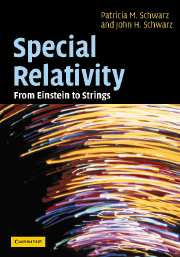Book contents
- Frontmatter
- Contents
- Preface
- Part I Fundamentals
- Part II Advanced Topics
- 7 When quantum mechanics and relativity collide
- 8 Group theory and relativity
- 9 Supersymmetry and superspace
- 10 Looking onward
- Appendix 1 Where do equations of motion come from?
- Appendix 2 Basic group theory
- Appendix 3 Lie groups and Lie algebras
- Appendix 4 The structure of super Lie algebras
- References
- Index
9 - Supersymmetry and superspace
Published online by Cambridge University Press: 06 July 2010
- Frontmatter
- Contents
- Preface
- Part I Fundamentals
- Part II Advanced Topics
- 7 When quantum mechanics and relativity collide
- 8 Group theory and relativity
- 9 Supersymmetry and superspace
- 10 Looking onward
- Appendix 1 Where do equations of motion come from?
- Appendix 2 Basic group theory
- Appendix 3 Lie groups and Lie algebras
- Appendix 4 The structure of super Lie algebras
- References
- Index
Summary
In Chapter 8 we learned that Lorentz boosts and rotations are part of a group called the Lorentz group. Adding translations in space and time, one gets an even larger group, called the Poincaré group. An understanding of this group is very helpful in the construction and interpretation of relativistic theories. Since a relativistic theory has the same basic equations in any inertial frame, these equations should be invariant – or transform among themselves – under all Poincaré group transformations. This places a severe restriction on the structure of allowed theories.
It is natural to ask whether theories could be restricted further by requiring that they have additional symmetries beyond those described by the Poincaré group. The answer, of course, is that there is a variety of possibilities for other types of symmetry besides those that are contained in the Poincaré group. In considering additional symmetries, we can make the following distinction: either the added symmetries act independently from the Poincaré symmetries or they do not. In the first case the additional symmetries form a group G by themselves, and the total symmetry of the theory is a product of the Poincaré symmetries and the G symmetries. In particular, this implies that the G symmetries commute with rotations, and therefore the generators of G must be rotationally invariant. In the second case – which is the one that is realized in supersymmetrical theories – there are new symmetry generators that are not rotationally invariant.
- Type
- Chapter
- Information
- Special RelativityFrom Einstein to Strings, pp. 287 - 311Publisher: Cambridge University PressPrint publication year: 2004

